

Because we had all been traveling for three days we were taken to our hotel which was on the shores of Kan Daw Gyi Lake and given the afternoon to nap, rest, or walk about, depending on our own desire. We would meet that evening for a "Welcome to Myanmar dinner."

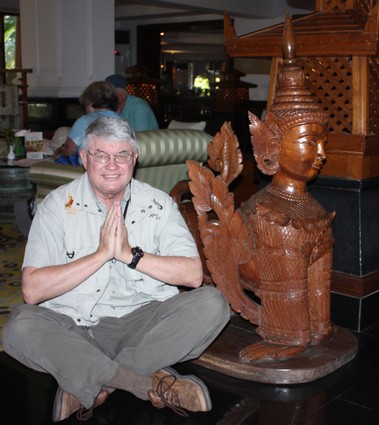 Practicing my Yoga before heading out for the day |
Thai Boxing is very popular |

Our first stop was to visit the Shwedagon [Golden] Pagoda. I wasn't prepared for what I was about to learn |
The Pagoda is in reality a mound to bury Buddhist relics. It is not a building That you can enter. |
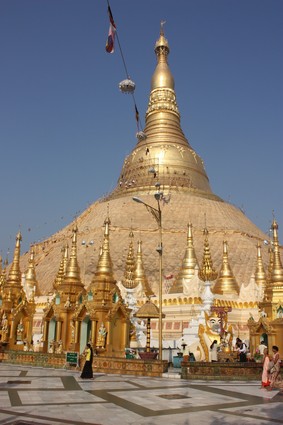 The Pagoda is surrounded by a complex of alcoves with statues of the Buddha and other shrines |
Every 10 years to dome is recovered with gold leaf |
Every alcove had a statue of the Buddha with people praying |
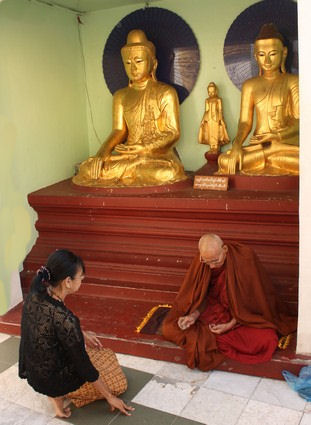 The faithful seek blessings from the Monks |
Monks are not allowed to handle gold or silver so any donation of money had to be placed in an envelope to be placed in a bowl. |
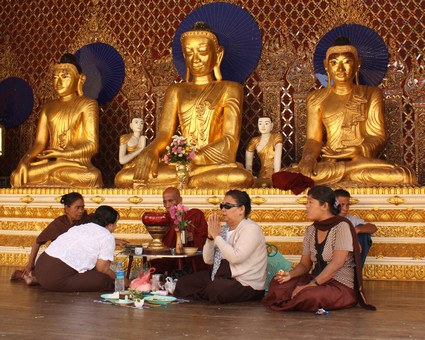 I called this one "Having lunch with the Buddha" |
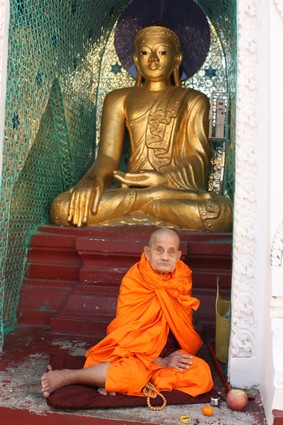 There were "saffron" robed Monks at every alcove |
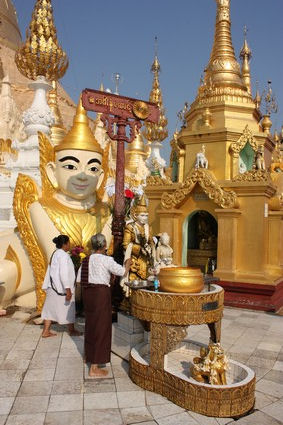 There is a Monk who knows the day of week for every date in history. This is important so you can find the statue that represents your birth day and pour cooling waters over the Buddha to wish for a peaceful life. Cool water symbolically quenches the fires of suffering. |
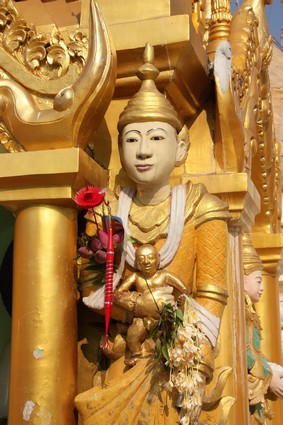 If you were childless, or wanted a son you gave flowers to a celestial figure to pray for sons or children. A mixture of Buddhist, Nat, or Hindu statues is not uncommon at a Pagoda. |
This is one place they don't frown of photographs |
Some places were more popular than others but they all had the same purpose |
It was remarkable how many places there were to pray to the Buddha. You just find your spot and seek your blessings. |
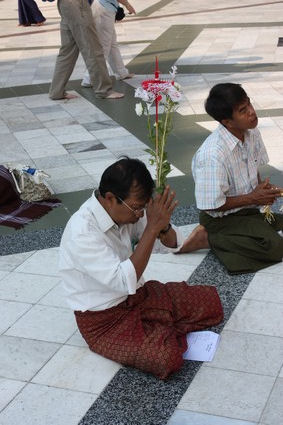 Flowers are offered in gratitude for Lord Buddha's teachings. Just as flowers fade we learn that nothing in life is permanent and enables the faithful to face uncertainties with serenity and composure. |
Not all Buddha's are seated. The reclining Buddha is also popular. Here the Buddha is just resting. |
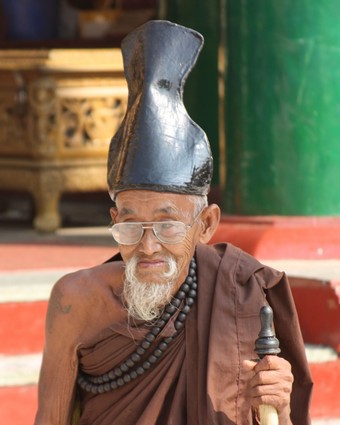 Not all monks are in "saffron" robes Generally you can tell what country a monk is from by the color of his robes, and I forgot to ask what this color means. And he wears a leather hat. |
As I mentioned, mixing Buddhist and Hindu symbols is acceptable. Here a Garuda eats a Naga, starting at the tail. |
Legend says that a prince once killed his father who was a lion,, and in remorse placed lion figures at pagodas so all pilgrims would approach the magnificent creatures with a sense of piety. |
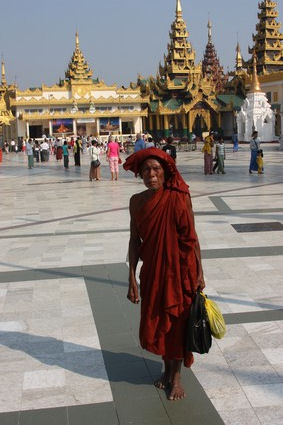 As the sun get higher in the sky the robe that may cover the shoulders for warmth in the morning becomes a hat for shade in the afternoon. |
It is customary to make an offering of the sweet smelling jasmine flowers to a Buddha. They can be bought from the local flower salesman. |
A husband and wife bring flowers for Buddha |
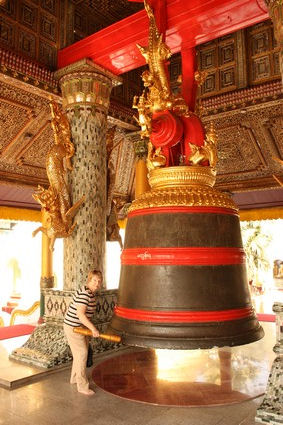 Not everyone can be a monk but everyone and try to "make merit". Such an event should not go unnoticed so you can ring the bell, three times, to announce to the world that you have made merit. Not a bad idea! |
One way to make merit is construct an alcove with a golden statute of Buddha |
There are bells everywhere for you to announce that you have made merit. Also monks to seek their blessing |
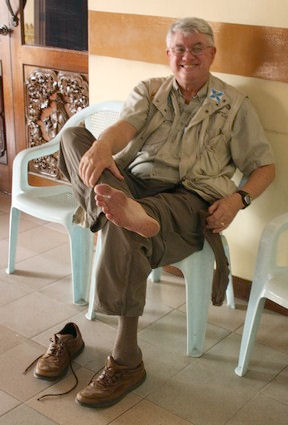 In Mynmar Pagoda grounds are holy and we must remove our shoes and socks. |

Downtown Yangon we see a lot of buildings left over from the "imperial colonial period. This is the Rowe and Co bulding - "the place" to shop |
The Burmese hated the British occupation so much they invited the Japanese in before WWII. The Japanese were very cruel. There are still damaged buildings in the middle of town |
Steet scenes give you an idea of a typical day. Notice how few cars there are. |
Hand carts are still a very common way to transport goods. |
Buddhism is an overwhelming force in society. Sending your children to the monastery for a free education is very common. Children honor their parents and grandparents by spending some time as a Monk. Here a child, maybe 12 years of age, is on the street with his alms bowl for food is a common sight. |
Busy market scene |
Shopping for food is a daily affair. Just bring your produce to the city, throw down a tarp, spread the fresh vegitables and fruit out and you have started a street market. |
See what I mean? |
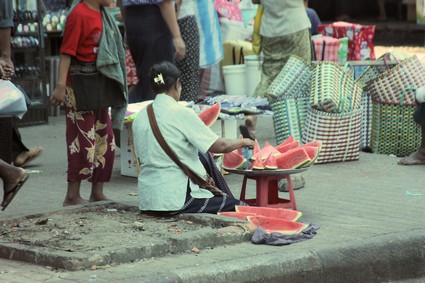 Fresh watermelon, not cold but juicy. |
Not many cars, some bikes. Most people get around taking the "bus" a converted pickup truck. Just yell when you want off. |
Lots of old apartment buildings that look like they haven't been repaired since WWII |
Very little air conditioning here although it is hot and humid. Just open the windows and balcony doors. |
18 June 2010
The Bo Gyoke Aung San Market
Once called Scott's Market when built in 1926. |
A unique indoor Oriental Bazaar with tiny stalls selling furniture, jewelery, crafts... |
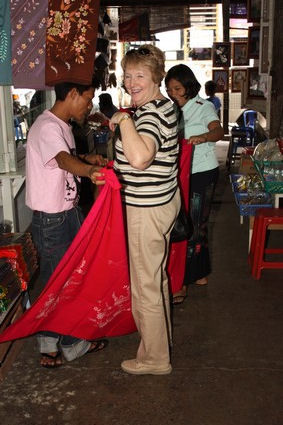 colorful fabrics to make a beach cover-up |
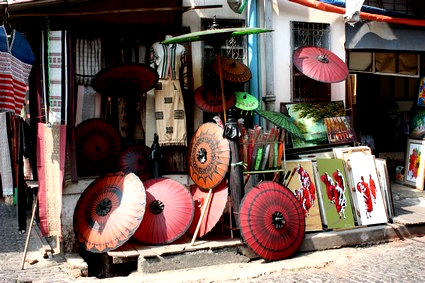 Paper umbrellas to shaded you from the sun |
food from local vendor |
local farmers set up food stalls on the street outside the market |
Lots of local color |
People visit and sell their product |
Are you looking for a puppy? |
Fresh fruit, but be careful, not all fruit tastes like oranges or apples. |
Fresh fish is available in Chinese markets |
Fruit and vegetables are always availabe |
Dried fish |
Fresh flowers for the Buddha or home |
Of course, fresh vegetables |
narrow street markets carried on a basket or tray on their heads. No cars or trucks can navigate these narrow pathways. |
Fresh fish caught in the river this morning |
Fresh poultry and eggs of any size and age - 1000 year eggs available |
Want meat instead, just walk down the street to the butcher |
Not everyone has an elaborate stand, just bring your produce and put it out for sale. |
Children always give us smiles |
Spices and pickled fish. |
Sell your vegetables by walking up an down the street |
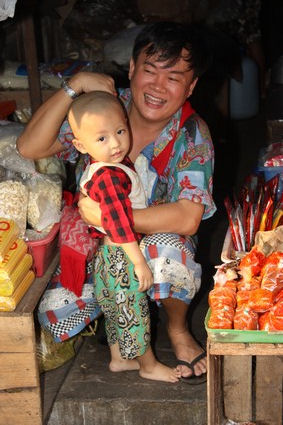 A father proudly shows his son |
If you are hungry you can stop for a hot meal. |
Here's your last chance to pick up some exotic fruit . . . |
It really is impossible to show all the great market photographs I have. I really found Myanmar to be an enchanting place and highly recommend it to anyone considering traveling in that part of the world.
The Wardan Jetty is full of ocean going frighters and water taxies |
Living in Yangon is expensive, land is cheaper across the river and the taxi fare is only 10 cents. |
When your taxi is empty you call out for more passengers |
Kids like their pictures taken even though the waterfront appears to be total chaos. |
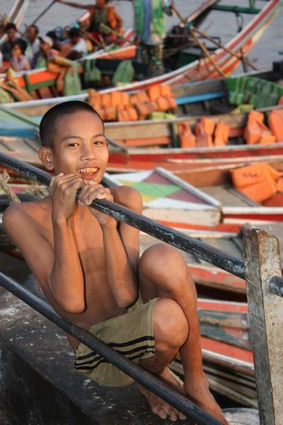 Young boys sit in the front of the taxi and when it gets close to shore they jump onto the cement jetty and pull the boat up, help passengers off and call for new customers |
Everyone lives on the the other side. |
Boats heading back to the other side |
Sometimes the river serves as your bathtub as well as a highway. |
When you get off the boat there is another form of cheap transportation |
Loading the bike with more than one passenger reduces the individual cost. |
Down at the waterfront ocean going freighters are loaded and unloaded by hand. They carry one sack from shore to the ship and another from the ship to shore. |
If you get paid per sack you may carry two sacks each way. |
During the summer while going to Hamline Univ I worked for the Renville county highway department. One summer we unloaded a railroad car filled with salt in 50 lb bags. Unloading that car was probably the hardest work I ever cared to do and I know that one day project was more than enough for a lifetime. None of us could do it now. |
Carrying cargo to/from the ship means you stay to the right. |
The taxies are all lined up along the wharf to ferry passengers. |
Anytime you want a rest or some relaxation you can take time to play a game. The board is drawn on the street and bottle caps serve as pieces |
Anywhere there are men working there are women setting up a "sandwich shop". Rice, bread, noodles and lots of sauces. |
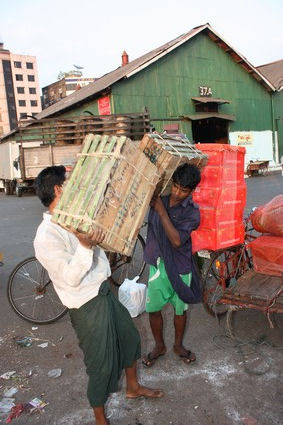 Not everyone loads sacks of rice, sometimes it is fresh vegetables. Maybe not so heavy but more bulk |
Lunch stands come in all shapes and sizes |
Besides small taxies to just cross the river there are larger ferries for longer journeys down river. |
I like hot spicy foods and the choices looked great and I wished I could have tried just one delicacy. |
Of course, something to drink, not necessarily cool, goes with a spicy meal |
Get on the ferry early and set up your vending station in a choice spot. |
Mothers everywhere love to show off their children. Here was the first time we noticed the face makeup which is so common in Burma |
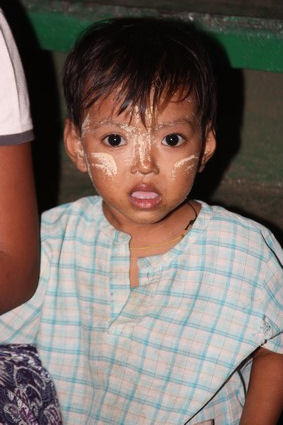 The makeup is worn by women and children |
Passengers throughout the world stand at ship's edge to watch the flurry of activity as the boat is being loaded. |
As we are literally pulled away from this wonderful area we look to the west and watch the sun set over the Yangon River |
At the end of our first full day in Myanmar we have our welcoming dinner in a lovely restaurant looking down at the lighted Sule Pagoda in downtown Yangon. Needless to say, I doubt many local people ever get to see this sight or eat here. |

(Editor's note, 5 August 2010: This page is still under construction so come back again.)
![]()
For more information about our travels write to![]() Belli.
Belli.